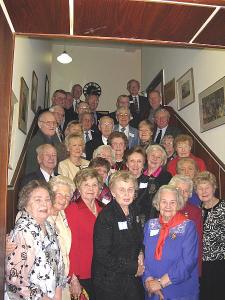The headlines of the newspapers around the world in 1948 read as follows:
In the Toronto Daily Star -- Halifax Opens Heart to 350 Refugees Who Fled Russian Domination in Tiny Converted Minesweeper
Refugee Laden Walnut Reaches Halifax
Euroopa jääb selja taha
See polnud laev, vaid mesipuu
What prompted this dangerous journey to Canada 60 years ago?
World War II had ended and many Estonians had escaped to Sweden. This, however, did not seem far enough away from the Russians who had taken over their country. The Russian government wanted the people, whom it considered its citizens, back. It was demanding the return of fugitives and refugees who had fled to Sweden.
One Walnut spokesman stated that the political trend in Sweden made it advisable to leave the country because the Swedish government had handed 140 Estonians back to the Russians.
Some Walnut passengers had spent time in Russian concentration camps. “A man cannot even talk unchecked to his best friend,” explained chief mate Arvid Berendson, an Estonian seaman. Captain Linde related that a sister, who was a harmless housewife, was whipped off to a Siberian camp and had not been heard from since. “With my own eyes I saw things happen to my countrymen that you would only believe if you saw it yourself,” he said. He remembered how his old navigation teacher at the merchant naval college had been tortured by the Russians. Along with seven other victims had their limbs broken and were lowered into a sixty foot well. “They were drowned ‘like rats’”, he said.
The refugees watched in horror as fellow Estonians were dragged from Sweden crying into boats and back to the Soviet Union. Rather than face the same fate, they decided to flee -- to Canada.
It was Alexander Kalbus who began soliciting funds for the purchase of the S.S.Walnut. The Walnut was bought from the British for a price of $60,000. It had been built as a Royal Navy minesweeper in 1939. She had an overall length of 164 feet and a width of 28 feet. $250 bought passage for an adult, $150 was the fare for a child.
It took three months to refit the Walnut for her voyage to the new world.
The ship originally designed for 14 men, was so crowded with her human load that the interior was like a honeycomb, each tiny space being utilized for accommodation.
The 347 passengers ranged in age from nine months to 80 years. Eight different ethnicities were represented on board. All knew that they faced illegal entry into Canada.
To ensure secrecy, the ship changed ports last minute and sailed from Lysekile. Even here, her departure was in jeopardy. There weren’t enough life preservers and 60 passengers were told to get off the ship. Customs officers and police asked all to get off and re-board using a shorter passenger list.
During re-boarding, an urgent telegram arrived for port officials from the Russian authorities – the boarding was to stop immediately! The Swedish port officials suspected what the telegram said and decided to open it AFTER the Walnut had sailed.
The missing 60 people? No, they were not left behind; they had been hidden, sealed in a room in the bottom of the ship. The Swedish port authorities had decided to turn a blind eye to room behind the pile of suitcases – the room they knew was there – but purposely decided NOT to investigate.
The vessel travelled from Sweden, through the North Sea, to the West of Ireland before the oceanic journey began. “We sailed north of Scotland through the North Sea to avoid the Russians, whom we suspected were attempting to re-capture us, stated the skipper of the Walnut.
A stop was made in Northern Ireland to pick up more coal. Four passengers were disembarked at Sligo, Ireland, when the ship remained there for four days. A marine engineer and his wife left the ship and berthed on a British ship to sail to Australia because they had Australian visas. One woman was put in hospital for an operation and the captain himself put a German passenger off the ship because he didn’t trust him.
Many perils awaited the Walnut on her long voyage. Trouble with the ship’s pumps resulted in three feet of water laying in the hold. Another foot of cold ocean water hitting hot boilers would have spelled disaster. With high waves crashing around them, men clung to railings, holding on for their lives, and bailed water. Someone came up with the idea of using fat to seal the deck opening. This sealed the coal chutes and kept out the water.
Stormy winter ocean waves washed over the deck of the tiny ship forcing passengers to cling to the railings or be washed overboard. With the number on board, the number of children, how no one was lost to the sea is a wonder.
And finally, after what seemed an eternity – seasick, suffering and hungry, the passengers spotted a strip of land off in the distance. It was the land they longed for and dreamed of – the saw Canada.
The Walnut arrived first in Sydney but immigration officials decided to have the shipload of passengers disembark at Halifax because the facilities there were better. The first passengers to step ashore were the Captain, his wife Hilda and their two small daughters Heili, aged 11 and Luule, aged 7.
Immigration authorities at Pier 21 placed the passengers in Immigration Barracks and at Rockhead Hospital – all were carefully screened – after all, only 15 passengers had visas to Canada. It was estimated that it would take six weeks time to screen all candidates for citizenship.
The voyage had been dangerous and uncomfortable – but no one had expected comfort. All they wanted was to get across the sea – to safety. This brave group of immigrants would have put up with anything to get to a free homeland. One immigration officer told a Walnut passenger, “You came to a good country – there is room for you here.”
How the Walnut carried its human cargo – almost 200 times the number of people it was designed to accommodate – is still a wonder. The only answer: God was looking out for these people.
Into God's Hands
A stormy sea
the water looms endless
cold and frigid
leaving behind forever
those we have loved
things we have known
all my possessions
in one small suitcase
memories are easy to pack
what lies ahead?
what fate awaits us?
will there be tomorrow?
together we came
with dread
filled yet with hope
into God’s hands
we placed our dreams
and our lives
deliver us all
from evil
Your kingdom come
we thank You
for this second chance
our lives anew
TR
(Remarks delivered at the reunion of the Walnut’s passengers, December 6, 2008)

60th anniversary of the Walnut’s arrival in Canada (3)
Archived Articles | 12 Dec 2008 | Eesti Elu
Viimased kommentaarid
Kommentaarid on kirjutatud EWR lugejate poolt. Nende sisu ei pruugi ühtida EWR toimetuse seisukohtadega.
Hello,
I don't speak estonian unfortunately, but I am the grandson of August Linde and would like to find out more about him. He past away in 1972 I think, I was only 5 years old. We lived with my grandfather and grandmother for a number of years and was very lucky to spend 5 great years with him. I am the son of Luule Linde if this helps at all. I am in contact with my aunt Heli on a regular bases and we would all like more info if possible.
Respectfully,
Troy Lazarowich
I don't speak estonian unfortunately, but I am the grandson of August Linde and would like to find out more about him. He past away in 1972 I think, I was only 5 years old. We lived with my grandfather and grandmother for a number of years and was very lucky to spend 5 great years with him. I am the son of Luule Linde if this helps at all. I am in contact with my aunt Heli on a regular bases and we would all like more info if possible.
Respectfully,
Troy Lazarowich
Sellist artiklit peaks avaldama ka kohalikes ajalehtedes. Tavalised kanadalasaed ei tea meie siia saabumise lugusi.
TR peaks saatma selle ka Toronto Star'i.
TR peaks saatma selle ka Toronto Star'i.
He is uncharacteristically silent in the face of this touching story.
Archived Articles
TRENDING






















